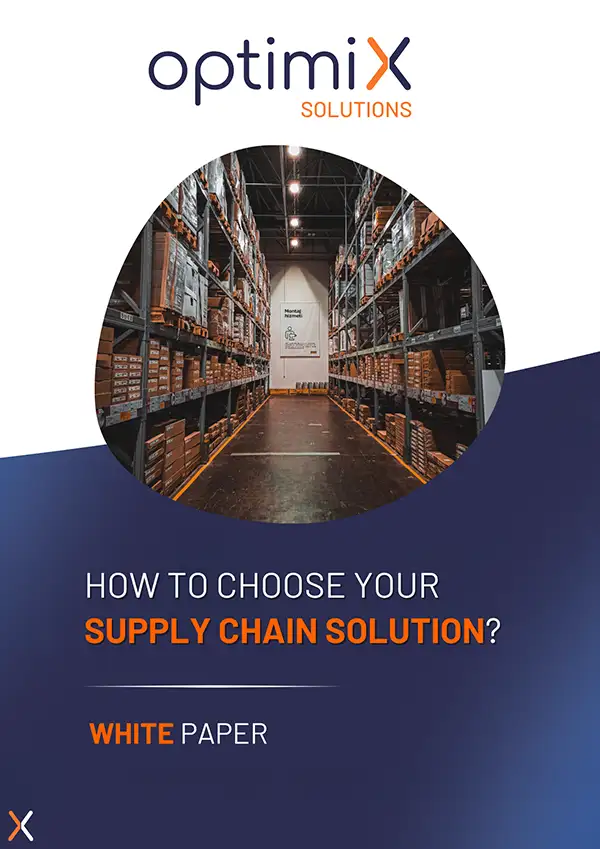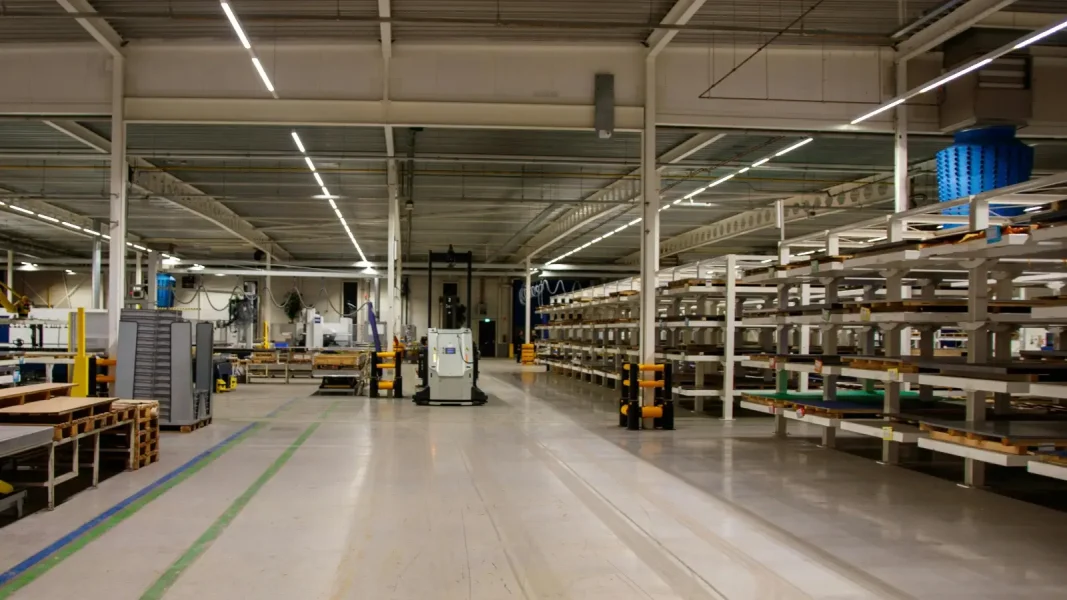Between unforeseen stock-outs, costly overstocks and ever-increasing logistics costs, many retail companies are struggling to stay on course. In a retail environment where competition is fierce and demand increasingly volatile, optimizing supply chain management is no longer just an operational issue: it has become a vital strategic lever enabling you tooptimize your inventories
Supply chain planning is no longer limited to filling shelves: it aims to respond nimbly to market fluctuations, while controlling operating costs and optimizing stock levels.
In this article, we present the levers of effective planning, backed by the technological expertise ofOptimix Solutions, a recognized specialist in APS (Advanced Planning and Scheduling) solutions. Its software solution XFR – Optimix Forecasting and Replenishment supports companies in optimizing their production and supply chain, by integrating forecasting, replenishment and intelligent flow management.
What is supply planning?
Supply chain planning covers all the activities required to ensure optimum supply of products or raw materials, taking into account forecast demand, logistical constraints and supplier lead times. It is a central element of supply management, aimed at guaranteeing the availability of products at the right time, while limiting costs linked to overstocking or shortages.
Three pillars structure this approach:
- Demand forecasting: analysis of sales history and trends to anticipate future needs.
- Inventory management: maintaining a balance between safety stock and active stock.
- Supplier coordination: making incoming flows more reliable by working effectively with logistics partners.
In the retail sector, where volume is high and seasonality is prevalent, supply planning is essential to avoid loss of sales and downtime costs.
The importance of supply planning in optimizing your supply chain
Intelligent supply planning is a real strategic lever in supply chain management. It contributes to overall corporate performance by aligning commercial, logistics and financial activities.
Key benefits of good supply planning :
- Lower logistics costs thanks to better anticipation of needs.
- Improved service rate: products available at the right time.
- Smoother flow of goods and cash.
- Optimize coordination between purchasing, sales and logistics.
Beyond the operational level, supply planning becomes a decision-making tool for management: adjusting budget targets, adapting sourcing strategies or launching new products.
Discover all the benefits here
Key stages in supply chain planning
An effective supply chain planning process is essential. It aligns customer demand and stock levels. This process is based on several key steps.
- First,demand analysis: we collect sales data and customer feedback.
- Next, we evaluate existing stocks. This helps identify overstocks and shortages.
- Net requirements are calculated by cross-referencing forecasts with actual inventories.
- The process continues with the selection of suppliers and the placing of orders.
- This is followed by goods receipt and inspection. This system enables continuous improvement.
- KPIs are analyzed to constantly adjust control parameters.
For a more detailed exploration of each step in this process, please see our full article: Steps to effective supply chain planning
Supply chain planning: the strategic role of the procurement plan
Supply chain planning goes far beyond logistics: it’s a strategic lever that directly influences profitability, agility and customer satisfaction. At the heart of this approach, the supply plan plays a central role. The backbone of the supply chain, it synchronizes customer demand with production and purchasing capacities, integrating sales forecasts, storage constraints, commercial priorities and supplier capacities.
An efficient supply plan has a dual objective: to avoid shortages without generating overstocks. It becomes a cross-functional management tool, linking purchasing, logistics, production, sales and finance. In a context marked by demand volatility, lead-time fluctuations and cost pressures, it must remain structured yet flexible.
Thanks to modern technological solutions, companies can model several scenarios, anticipate deviations and arbitrate rapidly. This enhanced visibility enables them to reduce risks, optimize costs and adapt to the vagaries of the market.
How does the procurement process work?
The procurement process covers all the steps involved in obtaining the goods and services a company needs for its business, at the right time, at the right cost and under the right conditions. It begins with the identification of internal needs, continues with the selection of suppliers, contract negotiation, order placement, logistics follow-up, and ends with the reception and control of deliveries.
This process is closely linked to supply chain planning, which enables us to anticipate needs, align resources and limit disruptions. Poor coordination between these stages can lead to delays, cost overruns or production stoppages, with a direct impact on the company’s overall performance.
For a full exploration of the subject, we invite you to consult the article: How the supply chain process works
Tools and software for better supply management
The digitization of the supply chain has put at your disposal a wide range of software tools, powered by artificial intelligence (AI), suitable for all company sizes and sectors. These solutions are designed to centralize data, automate processes and drive your flows in real time, transforming the way you manage inventory and procurement.
Modern ERP (Enterprise Resource Planning) systems offer a unified view of your operations, from inventory management to purchasing, production and sales. They are key allies for planning and traceability. AI-enhanced supply chain cloud platforms facilitate collaboration with suppliers and optimize order management in real time, as well as offering sourcing and performance monitoring tools.
For production companies, specialized AI-powered software lets you monitor stock levels, plan raw material requirements and optimize production cycles. These tools efficiently manage production orders and shopfloor flows, anticipating contingencies more accurately.
XFR - Optimix forecast and Replenishment: for optimal supply chain management
Today, reactivity and precision are essential. XFR by Optimix Solutions is a SaaS supply chain solution designed to centralize, make reliable and intelligently exploit all your data. This tool transforms supply planning into a real performance driver for your company.
- Unified, intelligent data management
For a complete overview, XFR consolidates data on sales, inventory, history, promotions, external events and suppliers into a single database. This integration guarantees consistency with your existing systems (ERP, WMS, POS, etc.). The solution then cleans, structures and makes your raw data reliable. This process is indispensable for obtaining reliable, usable sales forecasts and for stock optimization.
- AI and machine learning for accurate forecasts
Its advanced modeling engine, powered by artificial intelligence, learns from your historical data to identify trends and anticipate fluctuations. It takes into account seasonality, out-of-stocks, contingencies and the life-cycle of each product, and makes precise sourcing recommendations.
- Real-time control for informed decisions
Real-time visualization via dynamic dashboards lets you track your key indicators at a glance. You can monitor availability, stock coverage, service levels, out-of-stock conditions and supplier reliability. This clear, accessible data facilitates informed decision-making at all times.
Concrete, measurable results
+4% extra margin, +79% precision and +50% productivity for teams
The role of AI and machine learning in supply planning and management
Artificial intelligence and machine learning are profoundly transforming the way retail companies manage their supplies. These technologies make it possible to move from a reactive logic to a predictive approach, by exploiting historical data, consumer trends and weak market signals.
Key contributions of AI in the supply chain :
- Dynamic demand forecasting: algorithms continuously learn from past sales, seasonal events and customer behavior to anticipate needs with even greater precision.
- Optimization of stock levels: by cross-referencing sales data, supplier lead times and logistical constraints, AI recommends the optimum quantities to order to avoid shortages or overstocking.
- Detecting anomalies and risks: machine learning identifies unusual deviations in flows, delays or price variations, enabling proactive reaction.
- Intelligent automation: AI-driven systems can generate purchase orders, adjust restocking parameters and prioritize suppliers according to their performance.
Best practices for effective supply chain planning
Rely on reliable, up-to-date data: sales, inventory, supplier lead times, external events.
Integrate all relevant departments: purchasing, production, logistics, sales and finance.
Plan several scenarios to anticipate variations in demand, supplier shortages or regulatory changes.
Use advanced technological tools to centralize data, make forecasts more reliable and automate adjustments.
Monitor key indicators (service rate, stock coverage, supplier reliability) for continuous adjustment.
Social and Environmental Responsibility
Working with obsolete data that distorts forecasts.
Short-term planning without strategic vision.
Ignore the impact of promotions, seasonal events or market trends on demand.
Overestimating stock requirements “for safety’s sake”, leading to cost overruns and obsolescence.
Lack of interdepartmental communication, leading to inconsistent decisions.
By combining rigorous data collection, cross-functional collaboration and agile adjustments, planning becomes a strategic lever for optimizing costs, product availability and customer satisfaction.
Ultimately, supply chain planning is not just an operational function: it’s a genuine strategic lever for sustaining growth, improving profitability and building customer loyalty.
By integrating advanced APS solutions such as XFR-Optimix Forecast and Replenishment, retailers have a powerful tool to anticipate needs, reduce out-of-stocks, optimize inventory and gain agility.
Combined with human expertise, this data-driven solution transforms the supply chain into a sustainable competitive advantage, capable of adapting to market changes while controlling risks.







